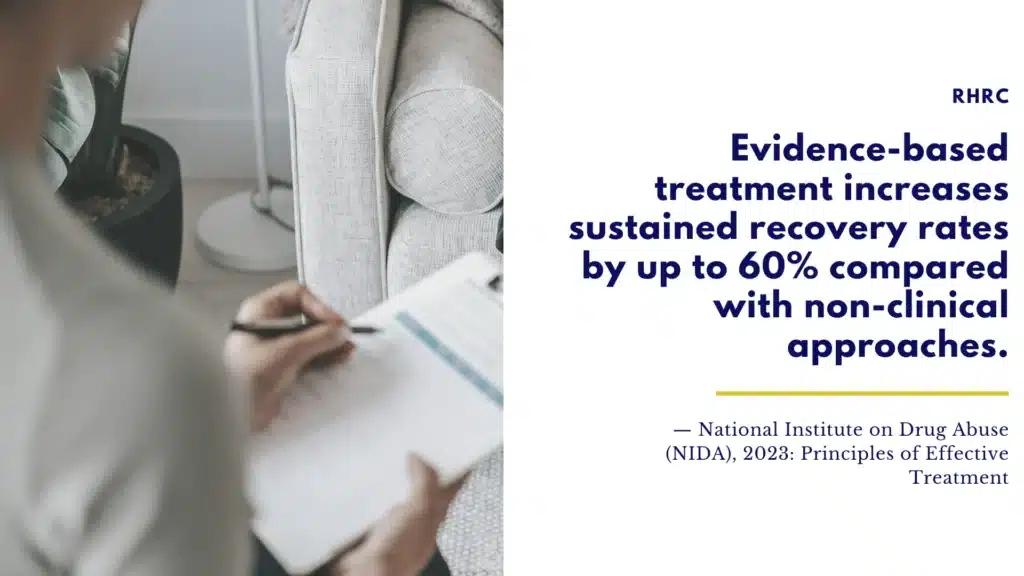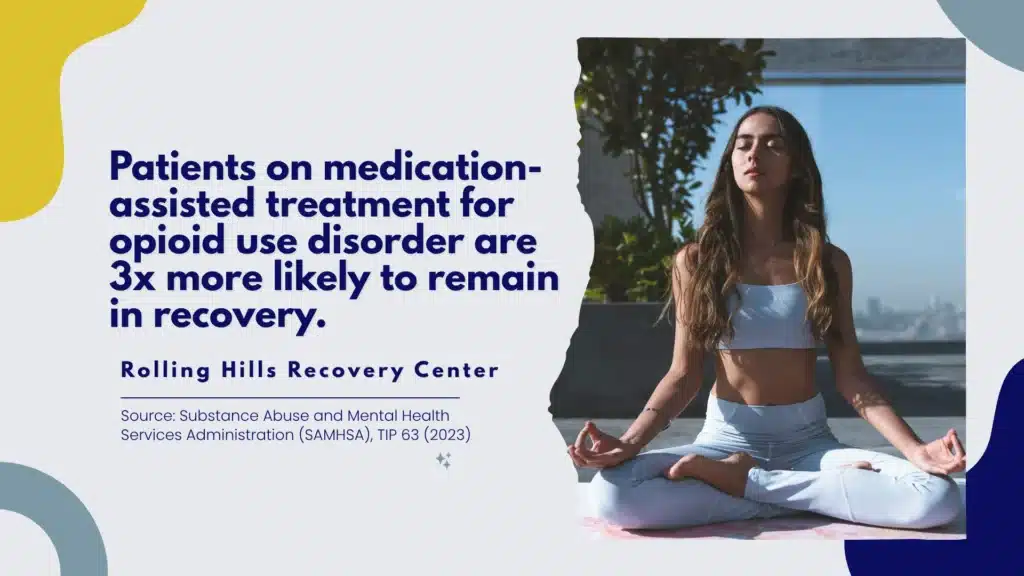Recovery begins with a clear plan, medical safety, and real support. This overview explains addiction treatment in New Jersey, from confidential assessment, placement across levels of care, and withdrawal management to therapies, family involvement, and relapse prevention.
Learn what to expect and how compassionate, structured care at Rolling Hills Recovery Center can move healing forward.
Key Takeaways
- Begin with a confidential screening; match the right level of care (detox, residential, PHP, IOP, outpatient) using ASAM criteria, set safety steps, and measurable goals.
- Medical withdrawal management matters: monitor vitals, prevent alcohol‑related seizures or delirium; use evidence‑based meds (buprenorphine or methadone for OUD, naltrexone, acamprosate or disulfiram for AUD), short‑term aids like clonidine or lofexidine, plus sleep & anxiety support.
- Therapies that help: CBT, motivational interviewing, contingency management, family work; integrate trauma‑informed care and treatment for depression, PTSD, or bipolar; practice daily skills and use tele‑psych tools when useful.
- Keep recovery going: overdose education, naloxone, fentanyl test strips; a cravings plan, trigger mapping, peer support (12‑step and non‑12‑step), case management for housing and transport; therapeutic drug testing and step up or down as needs change.
Assessment and Levels of Care

The best addiction treatment in NJ begins with a respectful, confidential screening. At Rolling Hills Recovery Center in New Jersey, the intake team follows evidence-based standards from ASAM and SAMHSA.
Because no prior search data was provided, the process outlined here uses widely adopted clinical criteria to place each person in the least restrictive, safe level of care.
Step-by-step intake
- First call or online inquiry: quick screen for safety, substance use, medications, and immediate needs (transport, childcare, work schedules).
- Insurance verification and benefits check: same day when possible; clear review of costs, co-pays, and financial assistance if available.
- Comprehensive assessment (60–90 minutes): medical history, psychiatric history, substance history (onset, frequency, route), prior treatment, overdose events, family/social supports, legal/work issues, suicide risk.
- Standardized tools:
- AUDIT or ASSIST for alcohol and drug risk.
- DAST-10 for drug-related problems.
- CIWA-Ar for alcohol withdrawal risk and severity.
- COWS for opioid withdrawal severity.
- PHQ-9 for depression, GAD-7 for anxiety, and PCL-5 for trauma symptoms.
- Columbia Suicide Severity Rating Scale (C-SSRS) for suicide risk.
- Brief Addiction Monitor (BAM) to track progress over time.
- Co-occurring evaluation: symptoms of depression, PTSD, bipolar spectrum, ADHD; screen for sleep apnea, chronic pain, peri-partum concerns, and cognitive issues.
- Physical exam and labs as indicated: vitals, pregnancy testing when appropriate, liver function, electrolytes; infectious disease screening offered.
- Individualized plan: clear safety priorities (overdose prevention, seizure risk), measurable goals, medications, therapy schedule, and family involvement plan. Plans are updated as new information emerges.
ASAM-aligned levels of care
- Withdrawal management (Medical Detox): 24/7 nursing and medical care to manage acute withdrawal and stabilize.
- Residential (24-hour structured setting): for those needing intensive support, safety monitoring, or who lack a stable environment.
- Partial Hospitalization Program (PHP): full days (typically 5–6 hours/day, 5 days/week), medical and psychiatric support, home nights.
- Intensive Outpatient Program (IOP): 9–15 hours/week of group and individual therapy; medication management.
- Outpatient (OP): 1–5 hours/week; counseling, medication follow-ups, recovery coaching.
A quick comparison
| Level of care | Who it fits | Medical needs | Typical duration |
|---|---|---|---|
| Detox | Moderate–severe withdrawal risk, recent heavy use, seizure risk | 24/7 monitoring, withdrawal meds | 3–7 days (varies) |
| Residential | High relapse risk, unsafe home setting, complex co-occurring | On-site medical & psychiatric | 2–4 weeks+ |
| PHP | Needs daily support but safe at home | Daytime medical/therapy | 2–4 weeks |
| IOP | Stable medically, needs structure & skills | Regular med follow-up | 6–12 weeks |
| OP | Stable, working toward long-term recovery | Med management as needed | Ongoing |
Co-occurring mental health care
- Integrated treatment is essential for depression, trauma-related disorders, bipolar disorder, and anxiety conditions. Symptoms are treated alongside substance use because separating the two often fails.
- Psychiatric evaluation guides medication choices and therapy dose. Collaboration with outside prescribers is coordinated through signed releases.
Care planning notes
- Goals are specific and measurable (e.g., “No unprescribed opioid use for 30 days,” “Attend 3 groups/week,” “PHQ-9 decreases by 5 points in 6 weeks”).
- Safety first: overdose education, naloxone access, and coordination with family or trusted supports if consent is given.
- Documentation uses standardized measures to track change, not to punish.
If substance use is disrupting daily life or relationships, it helps to start with a brief self-check and contact the team for next steps. See more on recognizing warning signs in our article: Are Drugs and Alcohol Making Life Unmanageable.
Medical Withdrawal Management and Medications

Supervised withdrawal (detox) reduces medical risks, improves comfort, and sets up the next phase of care. Protocols differ by substance.
Alcohol
- Onset and course: minor symptoms can begin 6–12 hours after last drink; seizures 12–48 hours; delirium tremens (DTs) 48–96 hours.
- Monitoring: frequent vitals, CIWA-Ar scoring, oxygen saturation, hydration, and electrolytes. Fall & aspiration precautions.
- Medications:
- Benzodiazepines (diazepam, chlordiazepoxide, or lorazepam) guided by CIWA-Ar.
- Thiamine before glucose to prevent Wernicke’s encephalopathy; folate and magnesium as needed.
- Antipsychotics are used for short-term treatment of severe agitation or hallucinations; cautious use.
- Transition meds for AUD: oral or extended-release naltrexone (if opioid-free), acamprosate for maintaining abstinence, disulfiram for specific use cases with monitoring.
Opioids (heroin, fentanyl, oxycodone, hydromorphone)
- Onset and course: short-acting opioids withdrawal peaks at 2–3 days; fentanyl can have delayed or prolonged symptoms. Methadone withdrawal lasts longer.
- Monitoring: vitals, COWS scores, hydration, GI symptoms, sleep, and pain.
- Medications:
- Buprenorphine: office- or home-based induction when appropriate; micro-induction techniques can reduce precipitated withdrawal risk, especially after fentanyl.
- Methadone: daily dosing in certified programs; considered when high tolerance, pregnancy, or prior benefit.
- Extended-release naltrexone: requires 7–10+ days opioid-free; fits those preferring an antagonist or who cannot take agonists.
- Non-opioid symptom aids: clonidine or lofexidine for autonomic symptoms; NSAIDs or acetaminophen for pain; anti-nausea agents; loperamide for diarrhea used appropriately; hydroxyzine or trazodone for anxiety/sleep.
- Pain management: multimodal approach; non-opioid analgesics, physical therapy, heat/ice, gentle movement; coordinate with specialists for chronic pain.
Benzodiazepines
- Risk: abrupt cessation can cause seizures and delirium.
- Approach: gradual taper using a long-acting benzodiazepine; seizure precautions; adjuncts for insomnia/anxiety (non-benzodiazepine options).
- Duration: weeks to months, depending on dose and chronicity.
Stimulants (cocaine, methamphetamine)
- Onset and course: crash phase with fatigue, sleep disruption, low mood; cravings fluctuate.
- Medical management: supportive care, sleep hygiene, exercise, nutrition. No FDA-approved medications for stimulant use disorder yet; treat co-occurring depression or anxiety when appropriate. Contingency management shows strong benefits.
Cannabis and nicotine
- Cannabis: irritability, sleep disturbance, appetite changes; treat with behavioral therapies and sleep strategies.
- Nicotine: NRT (patch, gum, lozenge), bupropion SR, or varenicline; integrate tobacco treatment into overall plan.
MAT is not an add-on; it is a core part of care for opioid and alcohol use disorders. For New Jersey residents seeking medication-focused care, see program details in our article about Rehab for Opioid Addiction in NJ.
Safety notes
- Pregnancy: methadone or buprenorphine are preferred for OUD; coordinate prenatal care.
- Liver disease: monitor LFTs; choose AUD meds based on hepatic function (acamprosate preferred with significant liver impairment).
- Overdose prevention: naloxone provided; education for patients & families.
Transition from detox
- Begin maintenance meds before discharge.
- Warm handoffs to PHP/IOP/outpatient on a set date and time.
- Clear crisis plan, refill plan, and 24/7 contact instructions.
Therapies That Work

“Evidence-based practices are the gold standard in substance abuse treatment as they are based on effective treatment results from scientific studies, this leads to better outcomes for long-term recovery.”
Laura Riley, LCADC | Rolling Hills Recovery Center
Evidence-based therapies are matched to the person’s needs and learning style. Frequency and format (group, individual, family) vary by level of care.
Core therapies
- Cognitive Behavioral Therapy (CBT): identify triggers, thoughts, feelings, and behaviors; build coping skills; plan for high-risk situations.
- Motivational Interviewing (MI): resolve ambivalence, strengthen change talk, respect autonomy.
- Contingency Management (CM): structured rewards for desired behaviors (negative UDTs, attendance, medication adherence).
- Community Reinforcement and Family Training (CRAFT): equip loved ones to support change; improves engagement.
- Family therapy: communication skills, boundary setting, relapse prevention at home, psychoeducation on addiction as a chronic condition.
- Trauma-informed care: safety, choice, collaboration, empowerment; pacing to avoid overwhelm during early recovery.
Integrated treatment for co-occurring disorders
- Depression, PTSD, bipolar disorder, anxiety, ADHD, and personality-related concerns are addressed along with substance use.
- Medication management is coordinated with therapy to reduce symptoms that drive use.
- Specialized tracks or consults can help stabilize mood and sleep before intensive trauma work begins. Learn more about integrated care in this article about Dual Diagnosis Treatment in NJ.
Skills practice and lifestyle supports
- Craving management: urge surfing, delay-distract-decide, opposite action, calling a support person early.
- Trigger mapping: people, places, times of day, emotions, and cues; plan replacements (gym at 6 pm instead of driving past former liquor store).
- Sleep hygiene: consistent schedule, reduce caffeine after noon, dark, cool room, no screens 60 minutes before bed; consider CBT for insomnia (e.g., stimulus control).
- Nutrition: regular meals, hydration, limit added sugar; vitamin repletion after alcohol use.
- Exercise: low-impact movement most days; activities that are realistic to maintain.
- Mindfulness and grounding: brief breathing drills, 5-senses check-ins, and guided relaxations.
- Pain coping: pacing, stretching, heat/cold, physical therapy exercises; limiting catastrophizing thoughts.
Digital and tele-psych supports
- Telehealth sessions can supplement in-person care when transportation or scheduling is a barrier.
- Digital CBT and recovery apps can provide between-session practice. Some individuals benefit from prescription digital therapeutics for substance or opioid use disorder, where available.
- Sleep tools: CBT-i strategies and reputable apps can help normalize circadian rhythm.
Documenting progress
- Use repeat measures: BAM every 2–4 weeks; PHQ-9/GAD-7 for mood and anxiety; craving ratings.
- Track medication adherence and side effects.
- Review UDT results therapeutically, not to punish, linking outcomes to changes in the plan.
Group and community connections
- Psychoeducation groups, process groups, skills practice, and wellness groups (sleep, nutrition, mindfulness).
- Alumni programs and peer support integration to build longer-term accountability.
Recovery Supports and Relapse Prevention
Recovery extends beyond the clinic. Building a practical, repeatable plan is critical.
Overdose risk and harm reduction
- Naloxone: keep it on hand; show loved ones how to use it. New Jersey pharmacies and community programs often carry it with standing orders.
- Fentanyl & drug supply risks: use fentanyl test strips when in doubt; never use alone; start with a small test dose; avoid mixing opioids with benzodiazepines or alcohol.
- Xylazine contamination: raises overdose and tissue injury risks; know local alerts; seek prompt wound care.
Relapse prevention plan (template)
- Warning signs:
- Increased stress, isolation, missing appointments, and romanticizing past use.
- Triggers:
- People, places, payday, pain flares, anger, loneliness, fatigue.
- My first steps when cravings hit:
- 3-minute breathing; text/call a support; leave the high-risk place; eat something; 20-minute walk.
- Alternatives:
- Gym, meeting, game, shower, cooking, calling family, and a hobby.
- Support contacts:
- Sponsor or mentor; two peers; therapist; crisis line.
- Boundaries:
- No cash carrying >$20; no bars or old hangouts; do not keep alcohol at home.
- Safety measures:
- Keep naloxone visible; label it for others; have a “check-in” buddy daily for the first month after discharge.
Trigger mapping worksheet (how-to)
- List the top 5 triggers you faced last week.
- For each, write the earliest cue you noticed (time, place, body sensation).
- Choose one coping action you actually used. Rate effectiveness 0–10.
- Choose one new action to try next time. Commit to testing it once this week.
Peer support options
- 12-step (AA/NA) and alternatives like SMART Recovery, Refuge Recovery, and LifeRing can all help. Try multiple and choose what fits.
- Peer recovery coaching pairs lived experience with accountability.
- Family support: Al-Anon, SMART Family & Friends, and CRAFT groups.
Case management
- Housing navigation (sober living when appropriate), transportation planning, legal and workplace letters, and school coordination.
- Vocational services: return-to-work readiness, FMLA paperwork, resume help.
Urine drug testing (UDT)
- Used therapeutically: to inform care, not to discharge. Frequency based on risk, medications, and level of care.
- Discuss results openly; adjust plan early when risk rises.
Sustained monitoring
- Frequent contact in the first 90 days; then taper contact while maintaining a path to re-engage quickly.
- Schedule “booster” skills sessions before known stressors (holidays, anniversaries, court dates).
Return-to-use response (step-by-step)
-
- Ensure safety: naloxone access, medical check if needed.
- Rapid appointment within 24–72 hours.
- Review what happened without shame; update triggers & skills list.
- Adjust medications (e.g., consider buprenorphine dose, add acamprosate).
- Increase structure (move from OP to IOP/PHP or brief residential).
- Confirm emergency contacts & crisis plan.

Getting Started in New Jersey
What to expect in week one
- Day 1: intake, vitals, lab orders if needed, medication reconciliation, safety planning, consent forms, and HIPAA releases explained.
- Day 2: medical provider visit, initial medication plan, orientation to groups, digital portal setup.
- Day 3–4: therapy sessions (individual + group), family outreach with consent, case management screening (housing, transport, legal, work).
- Day 5: finalize treatment schedule (PHP/IOP/OP), first recovery plan draft, naloxone pickup, weekend supports arranged.
- Ongoing: standardized measures (BAM, PHQ-9, GAD-7) every 1–2 weeks; medication follow-ups weekly at first.
Insurance and cost transparency
- Benefits verification before admission; clear explanation of in-network vs. out-of-network coverage, deductibles, and co-pays.
- Prior authorizations handled by the admissions team; assistance with single case agreements when needed.
- Upfront cost estimates provided. Financial counseling is available to discuss payment plans if applicable.
Transportation and family involvement
- Help arrange rides to the location when possible; public transit options reviewed; telehealth sessions for those far from the center when appropriate.
- Family participation: With consent, the family is invited to education sessions and therapy. CRAFT and boundary-setting are encouraged.
HIPAA privacy
- Personal health information is protected. Disclosures happen only with signed consent or as required for safety and law.
- Patients control who is contacted, what is shared, and for what purpose.
How to prepare and what to bring
- Identification, insurance card, and a list of current medications (bring prescriptions in original containers).
- Comfortable clothing, a notebook, charger, and any medical devices.
- For residential: toiletries (no aerosols), slip-on shoes, reading materials, and a small amount of cash. Leave valuables at home.
- Contact information for primary care and specialists.
Coordination with primary care and specialists
- With signed releases, the clinical team coordinates medication reconciliation, lab follow-up, and specialty care (pain, psychiatry, infectious disease, OB).
- Pregnant individuals receive expedited coordination with obstetrics.
- Post-discharge, a care summary is shared with approved providers, including medication lists, crisis plan, and follow-up appointments.
When to escalate or step down care
- Step up to higher care if:
- Uncontrolled withdrawal or medical issues.
- Frequent use despite OP/IOP.
- Suicide risk or severe mood instability.
- Unsafe home environment or risk of violence.
- Step down when:
- Stable abstinence or controlled use with agreement.
- Reliable medication adherence and consistent attendance.
- Measurable improvement on BAM, PHQ-9, and GAD-7.
- Transitions are planned; no gaps between levels. Discharge always includes a safety plan, naloxone, and clear follow-up.
Emergency situations
- Call 911 for overdose or severe withdrawal signs (seizures, confusion, chest pain, trouble breathing).
- Use naloxone for suspected opioid overdose; rescue breathing while awaiting EMS.
- Contact the on-call line for urgent but non-emergent issues; instructions are provided at intake.
Key References for Clinicians and Families
- NIDA Principles of Effective Treatment: NIDA principles of effective treatment
- Medications for Opioid Use Disorder (TIP 63): SAMHSA Medications for Opioid Use Disorder (TIP 63)
- CDC Overdose Prevention resources and data: https://www.cdc.gov/overdose/
- ASAM: ASAM Criteria overview
Conclusion
Care works when assessment & placement, medications, and therapy come together… Plans are personal, support continues, family and wellness matter. Start now with Rolling Hills Recovery Center today.
Frequently Asked Questions (FAQs)
What is Treatment for Substance Abuse, and How Does it Start?
Treatment for substance abuse starts with a private assessment to check health, substance use history, and mental health needs.
Clinicians match the person to the right level of care (detox, residential, partial hospitalization, intensive outpatient, or outpatient).
If withdrawal is likely, medically supervised detox may come first to keep it safe. From there, evidence-based therapy, medication when indicated, and family support are added. Care plans are updated as progress is made, not set in stone.
Does Medication Play a Role in Treatment for Substance Abuse?
Yes, medications can be vital in treatment for substance abuse. For opioid use disorder, buprenorphine or methadone reduces cravings and overdose risk; naltrexone can help in some cases.
For alcohol use disorder, acamprosate, naltrexone, or disulfiram may support recovery. Short-term aids like clonidine or lofexidine can ease withdrawal symptoms. Medication works best alongside therapy, monitoring, and recovery supports.
How Long Does Treatment for Substance Abuse Take in New Jersey?
Treatment for substance abuse does not follow one clock. Detox can last 3–7 days, residential care often 2–6 weeks, partial hospitalization 2–4 weeks, intensive outpatient 8–12 weeks, and outpatient care may continue for months.
The timeline depends on medical stability, mental health, support at home, and goals. Progress over perfection, care steps up or down as needed.
Will Insurance Cover Treatment for Substance Abuse, and What Will it Cost?
Many health plans help cover treatment for substance abuse, including evaluation, detox, medications, and therapy. Exact costs depend on the level of care, length of stay, deductibles, and network rules.
Benefits can be verified quickly, and financial counseling can clarify any out-of-pocket amounts, with no surprises if possible.
Clinically appropriate care comes first; coverage details are reviewed so treatment matches medical need and budget.
Author
-
Our editorial team includes licensed clinicians and board-certified addiction specialists. Every article is written and reviewed to be clear, accurate, and rooted in real treatment experience.
View all posts -
Dr. Williams has held senior leadership positions in the behavioral health field for over 30 years. He has worked with diverse populations in various private and public sectors.
View all posts












